Hundreds of millions of light years away, a supermassive black hole sits in the center of a galaxy cluster named Ophiuchus. Though black holes are renowned for sucking in surrounding material, they sometimes expel material in jets. This black hole is the site of an almost unimaginably powerful explosion, created when an enormous amount of material was expelled.
Continue reading “Astronomers Have Recorded the Biggest Explosion Ever Seen in the Universe”Matter is Going Into this Black Hole at 30% the Speed of Light

A team of researchers in the UK have observed matter falling into a black hole at 30% the speed of light. This is much faster than anything previously observed. The high velocity is a result of misaligned discs of material rotating around the black hole.
Continue reading “Matter is Going Into this Black Hole at 30% the Speed of Light”
That’s Strange. Jupiter’s Northern and Southern Auroras Pulse Independently
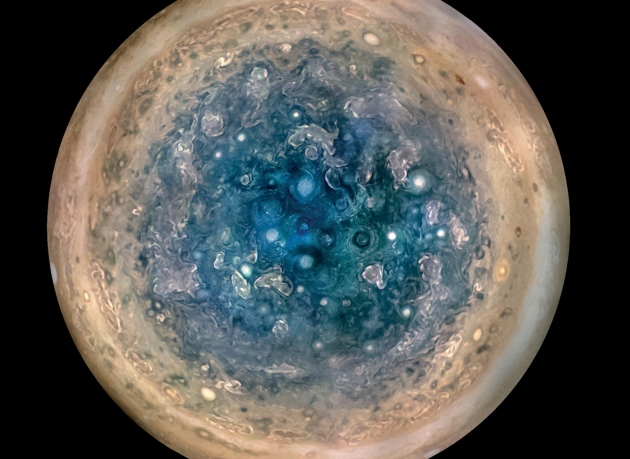
In addition to being the largest and most massive planet in our Solar system, Jupiter is also one of its more mysterious bodies. This is certainly apparent when it comes to Jupiter’s powerful auroras, which are similar in some ways to those on Earth. In recent years, astronomers have sought to study patterns in Jupiter’s atmosphere and magnetosphere to explain how aurora activity on this planet works..
For instance, an international team led by researchers from University College London recently combined data from the Juno probe with X-ray observations to discern something interesting about Jupiter’s northern and southern auroras. According to their study, which was published in the current issue of the scientific journal Nature – Jupiter’s intense, Jupiter’s X-ray auroras have been found to pulsate independently of each other.
The study, titled “The independent pulsations of Jupiter’s northern and southern X-ray auroras“, was led by William Richard Dunn – a physicist with the Mullard Space Science Laboratory and The Center for Planetary Science at UCL . The team also consisted of researchers from the Harvard-Smithsonian Center for Astrophysics (CfA), the Southwest Research Institute (SwRI), NASA’s Marshall Space Flight Center, the Jet Propulsion Laboratory, and multiple research institutions.

As already noted, Jupiter’s auroras are somewhat similar to Earth’s, in that they are also the result of charged particles from the Sun (aka. “solar wind”) interacting with Jupiter’s magnetic field. Because of the way Jupiter and Earth’s magnetic fields are structured, these particles are channeled to the northern and southern polar regions, where they become ionized in the atmosphere. This results in a beautiful light display that can be seen from space.
In the past, auroras have been spotted around Jupiter’s poles by NASA’s Chandra X-ray Observatory and by the Hubble Space Telescope. Investigating this phenomena and the mechanisms behind it has also been one of the goals of the Juno mission, which is currently in an ideal position to study Jupiter’s poles. With every orbit the probe makes, it passes from one of Jupiter’s poles to the other – a maneuver known as a perijove.
For the sake of their study, Dr. Dunn and his team were forced to consult data from the ESA’s XMM-Newton and NASA’s Chandra X-ray observatories. This is due to the fact that while it has already acquired magnificent images and data on Jupiter’s atmosphere, the Juno probe does not have an X-ray instrument aboard. Once they examined the X-ray data, Dr. Dunn and his team noticed a difference between Jupiter’s northern and southern auroras.
Whereas the X-ray emissions at the north pole were erratic, increasing and decreasing in brightness, the ones at the south pole consistently pulsed once every 11 minutes. Basically, the auroras happened independently of each other, which is different from how auroras on Earth behave – i.e. mirroring each other in terms of their activity. As Dr. Dunn explained in a recent UCL press release:
“We didn’t expect to see Jupiter’s X-ray hot spots pulsing independently as we thought their activity would be coordinated through the planet’s magnetic field. We need to study this further to develop ideas for how Jupiter produces its X-ray aurora and NASA’s Juno mission is really important for this.”
The X-ray observations were conducted between May and June of 2016 and March of 2017. Using these, the team produced maps of Jupiter’s X-ray emissions and identified hot spots at each pole. The hot spots cover an area that is larger than the surface area of Earth. By studying them, Dr. Dunn and his colleagues were able to identify patterns of behavior which indicated that they behaved differently from each other.
Naturally, the team was left wondering what could account for this. One possibility they suggest is that Jupiter’s magnetic field lines vibrate, producing waves that carry charged particles towards the poles. The speed and direction of these particles could be subject to change over time, causing them to eventually collide with Jupiter’s atmosphere and generate X-ray pulses.
As Dr Licia Ray, a physicist from Lancaster University and a co-author on the paper, explained:
“The behavior of Jupiter’s X-ray hot spots raises important questions about what processes produce these auroras. We know that a combination of solar wind ions and ions of Oxygen and Sulfur, originally from volcanic explosions from Jupiter’s moon, Io, are involved. However, their relative importance in producing the X-ray emissions is unclear.”
And as Graziella Branduardi-Raymont- a professor from UCL’s Space & Climate Physics department and another co-author on the study – indicated, this research owes its existence to multiple missions. However, it was the perfectly-timed nature of the Juno mission, which has been in operation around Jupiter since July 5th, 2016, that made this study possible.

“What I find particularly captivating in these observations, especially at the time when Juno is making measurements in situ, is the fact that we are able to see both of Jupiter’s poles at once, a rare opportunity that last occurred ten years ago,” he said. “Comparing the behaviours at the two poles allows us to learn much more of the complex magnetic interactions going on in the planet’s environment.”
Looking ahead, Dr. Dunn and his team hope to combine X-ray data from XMM-Newton and Chandra with data collected by Juno in order to gain a better understanding of how X-ray auroras are produced. The team also hopes to keep tracking the activity of Jupiter’s poles for the next two years using X-ray data in conjunction with Juno. In the end, they hope to see if these auroras are commonplace or an unusual event.
“If we can start to connect the X-ray signatures with the physical processes that produce them, then we can use those signatures to understand other bodies across the Universe such as brown dwarfs, exoplanets or maybe even neutron stars,” said Dr. Dunn. “It is a very powerful and important step towards understanding X-rays throughout the Universe and one that we only have while Juno is conducting measurements simultaneously with Chandra and XMM-Newton.”
In the coming decade, the ESA’s proposed JUpiter ICy moons Explorer (JUICE) probe is also expected to provide valuable information on Jupiter’s atmosphere and magnetosphere. Once it arrives in the Jovian system in 2029, it too will observe the planet’s auroras, mainly so that it can study the effect these have on the Galilean Moons (Io, Europa, Ganymede and Callisto).
Further Reading: UCL, ESA, Nature Astronomy
Stunning View of the Crab Nebula Just Got Five Times Better

Images of the Crab Nebula are always a treat because it has such intriguing and varied structure. Also, just knowing that this stellar explosion was witnessed and recorded by people on Earth more than 900 years ago (with the supernova visible to the naked eye for about two years) gives this nebula added fascination.
A new image just might be the biggest Crab Nebula treat ever, as five different observatories combined forces to create an incredibly detailed view, with stunning details of the nebula’s interior region.
Data from the five telescopes span nearly the entire breadth of the electromagnetic spectrum, from radio waves seen by the Karl G. Jansky Very Large Array (VLA) to the powerful X-ray glow as seen by the orbiting Chandra X-ray Observatory. And, in between that range of wavelengths, the Hubble Space Telescope’s crisp visible-light view, and the infrared perspective of the Spitzer Space Telescope.
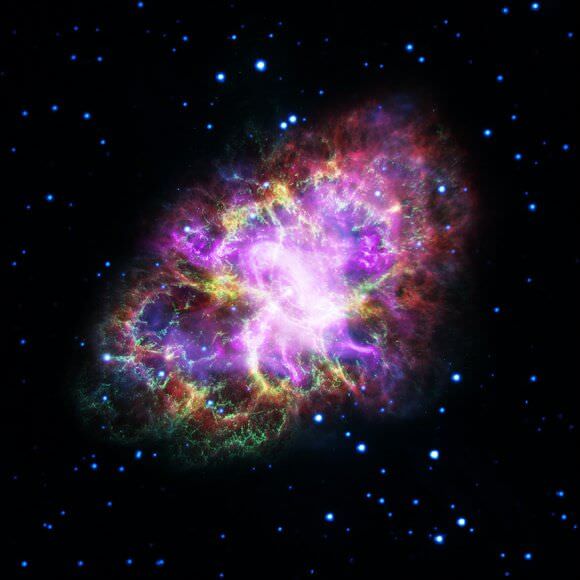
The Crab is 6,500 light-years from Earth and spans about 10 light-years in diameter. The supernova that created it was first witnessed in 1054 A. D. At its center is a super-dense neutron star that is as massive as the Sun but with only the size of a small town. This pulsar rotates every 33 milliseconds, shooting out spinning lighthouse-like beams of radio waves and light. The pulsar can be seen as the bright dot at the center of the image.
Scientists say the nebula’s intricate shape is caused by a complex interplay of the pulsar, a fast-moving wind of particles coming from the pulsar, and material originally ejected by the supernova explosion and by the star itself before the explosion.
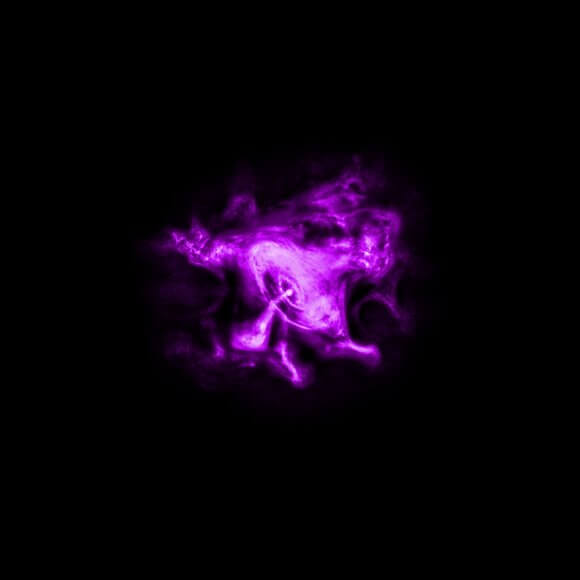
For this new image, the VLA, Hubble, and Chandra observations all were made at nearly the same time in November of 2012. A team of scientists led by Gloria Dubner of the Institute of Astronomy and Physics (IAFE), the National Council of Scientific Research (CONICET), and the University of Buenos Aires in Argentina then made a thorough analysis of the newly revealed details in a quest to gain new insights into the complex physics of the object. They are reporting their findings in the Astrophysical Journal (see the pre-print here).
About the central region, the team writes, “The new HST NIR [near infrared] image of the central region shows the well-known elliptical torus around the pulsar, composed of a series of concentric narrow features of variable intensity and width… The comparison of the radio and the X-ray emission distributions in the central region suggests the existence of a double-jet system from the pulsar, one detected in X-rays and the other in radio. None of them starts at the pulsar itself but in its environs.”
“Comparing these new images, made at different wavelengths, is providing us with a wealth of new detail about the Crab Nebula. Though the Crab has been studied extensively for years, we still have much to learn about it,” Dubner said.

Read the team’s paper: Morphological properties of the Crab Nebula: a detailed multiwavelength study based on new VLA, HST, Chandra and XMM-Newton images
Sources: Chandra, Hubble
Delving Into The Mystery Of Black Hole Jets
The concept of a black hole jet isn’t a new one, but we still have a lot to learn about the mixture of particles found in the vicinity of them. Through the use of ESA’s XMM-Newton Observatory, astronomers have been taking a look at a black hole in our galaxy and found some surprising results.
As we know, stellar mass black holes take on materials from nearby stars. Matter from these companion stars is pulled away from the parent body toward the black hole and radiates a temperture so intense that it emits X-rays. However, a black hole doesn’t always ingest everything that comes its way. Sometimes they reject small portions of this incoming mass, pushing it away in the form of a set of powerful jets. These jets also feed the surroundings, releasing both mass and energy… robbing the black hole of fuel.
Through the study of jet composition, researchers are able to better determine what gets taken into a black hole and what doesn’t. Through observations taken at the radio wavelength of the electromagnetic spectrum, we have seen electrons crusing along at nearly the speed of light. However, it hasn’t been clearly determined whether the negative charge of the electrons is complemented by their anti-particles, positrons, or rather by heavier positively-charged particles in the jets, like protons or atomic nuclei.” With XMM-Newton’s power behind them, astronomers have had the opportunity to examine a black hole binary system called 4U1630–47 – a candidate known to have unexpected outbursts of X-rays for segments of time which last between months and years.
“In our observations, we found signs of highly ionised nuclei of two heavy elements, iron and nickel,” says María Díaz Trigo of the European Southern Observatory in Munich, Germany, lead author of the paper published in the journal Nature. “The discovery came as a surprise – and a good one, since it shows beyond doubt that the composition of black hole jets is much richer than just electrons.”
During September 2012, a team of astronomers headed up by Dr. Díaz Trigo and collaborators, observed 4U1630–47 with XMM-Newton. They also backed up their observations with near-simultaneous radio observations taken from the Australia Telescope Compact Array. Even though the studies were done close to each other – within just a couple of weeks – the results couldn’t have been more different.
According to Trigo’s team, the initial set of observations picked up X-ray signatures from the accretion disc, but there was no activity in the radio band. This is an indicator that the jets weren’t active at that time. However, in the second set of observations, there was activity in both X-ray and radio… the jets had turned back on! While examining the X-ray data from the second set, they also found iron nuclei in motion. These particles were moving both toward and away from XMM-Newton – proof the ions were part of twin jets aimed in opposite directions. However, that’s not all. There was also evidence of nickel nuclei pointing toward the observatory.
“From these ‘fingerprints’ of iron and nickel, we could show that the speed of the jet is very high, about two-thirds of the speed of light,” says co-author James Miller-Jones from the Curtin University node of the International Centre for Radio Astronomy Research in Perth, Australia.
“Moreover, the presence of heavy atomic nuclei in black hole jets means that mass and energy are being carried away from the black hole in much larger amounts than we previously thought, which may have an impact on the mechanism and rate by which the black hole accretes matter,” adds co-author Simone Migliari from the University of Barcelona, Spain.
Astounding new findings? Well… yeah. For a typical stellar-mass black hole, this is the first time that heavy nuclei has been detected within the jets. As of the present, there is only “one other X-ray binary that shows similar signatures from atomic nuclei in its jets – a source known as SS 433. This black hole system, however, is characterised by an unusually high accretion rate, which makes it difficult to compare its properties to those of more ordinary black holes.” Through these new observations of 4U1630–47, astronomers will be able to fill in information gaps about what causes jets to occur in black hole accretion disks and what drives them.
“While we now know a great deal about black holes and what happens around them, the formation of jets is still a big puzzle, so this observation is a major step forward in understanding this fascinating phenomenon,” says Norbert Schartel, ESA’s XMM-Newton Project Scientist.
Original Story Source: ESA Press Release.
“Blue” Exoplanet Now Seen in X-rays for the First Time
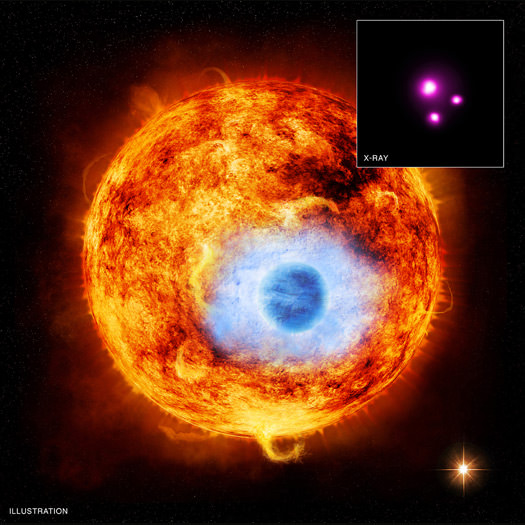
In the medical field, X-rays are used for finding and diagnosing all sorts of ailments hidden inside the body; in astronomy X-rays can also be used to study obscured objects like pulsars and black holes. Now, for the first time, X-rays have been used to study another object in space that tends to be difficult to spot: an extra solar planet. The Chandra X-ray Observatory and the XMM Newton Observatory combined their X-ray super powers to look at an exoplanet passing in front of its parent star.
This is not a new detection of an exoplanet – this same exoplanet, named HD 189733b has been one of the most-observed planets orbiting another star, and was recently in the news for Hubble confirming the planet’s ocean-blue atmosphere and the likelihood of having glass raining down on the planet.
But being able to see the exoplanet in X-rays is good news for future studies and perhaps even detections of planets around other stars.
“Thousands of planet candidates have been seen to transit in only optical light,” said Katja Poppenhaeger of Harvard-Smithsonian Center for Astrophysics (CfA) in Cambridge, Mass., who led the new study, which will be published in the Aug. 10 edition of The Astrophysical Journal. “Finally being able to study one in X-rays is important because it reveals new information about the properties of an exoplanet.”
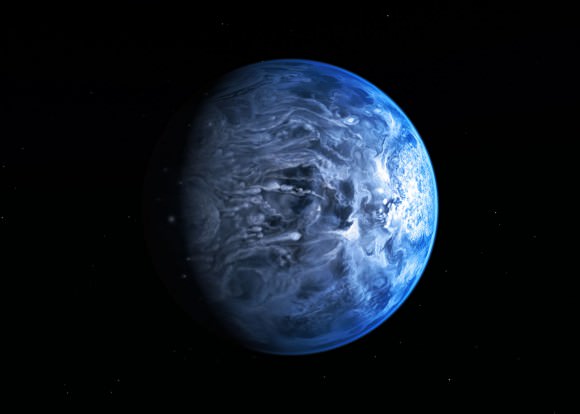
HD 189733b is a Jupiter-sized extrasolar planet orbiting a yellow dwarf star that is in a binary system called HD 189733 in the constellation of Vulpecula, near the Dumbell Nebula, approximately 62 light years from Earth.
This huge gas giant orbits very close to its host star and gets blasted with X-rays from its star — tens of thousands of times stronger than the Earth receives from the Sun — and endures wild temperature swings, reaching scorching temperatures of over 1,000 degrees Celsius. Astronomers say it likely rains glass (silicates) – sideways — in howling 7,000 kilometer-per-hour winds.
But it is relatively close to Earth, and so it has been oft-studied by many other space and ground-based telescopes.
In a blog post, Poppenhaeger said she was inspired by the launch of the Kepler telescope, and wondered if exoplanets could be seen in X-rays. She was excited when she found archived data from XMM Newton showing a fifteen hour long observation of the star HD 189733 and the “Hot Jupiter” HD 189733b was crossing in front of the star during that observation.
But the light curve was disappointing, she said. “The star is magnetically active, meaning that its corona is bright and flickering, so its X-ray light curve showed lots of scatter. Looking for a transit signal in this light curve was like trying to hear a whisper in a noisy pub,” Poppenhaeger wrote.
She knew with more data, the transit signal would be clearer, so she applied for – and got – time on Chandra to observe this exoplanet.
She combined the data from all the observations and was finally successful. “I could detect the transit of the planet in X-rays,” Poppenhaeger said. “What surprised me was how deep the transit was: The planet swallowed about 6-8% of the X-ray light from the star, while it only blocked 2.4% of the starlight at optical wavelengths. That means that the planet’s atmosphere blocks X-rays at altitudes of more than 60,000 km above its optical radius – a 75% larger radius in X-rays!”
That means that the outer atmosphere has to be heated up to about 20,000 K to sustain itself at such high altitudes. Additionally, the planet loses its atmosphere about 40% faster than thought before.
Poppenhaeger said she and her colleagues will test more X-ray observations of other similar planets such as CoRoT-2b to learn more about how stars can affect a planet’s atmosphere.
Sources: Chandra, Chandra Blog.


